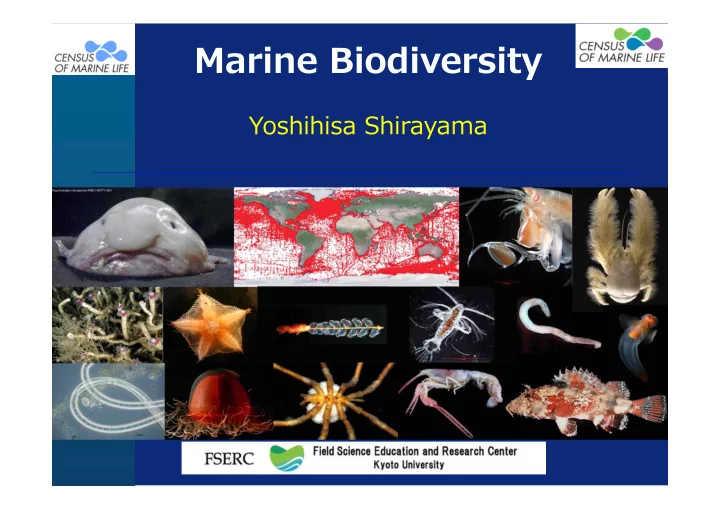

Marine Biodiversity Yoshihisa Shirayama
Contents Contents • Characteristics of Marine Biodiversity • Current status of knowledge • Challenge to census all marine organisms • Census of Marine Life Project
Characteristics of Marine Animal Characteristics of Marine Animal Biodiversity Biodiversity Terrestrial Marine Phyla Only limited groups Almost all phyla Known species 1.5 Million 0.25 Million Estimated total species 40 M 10-100 M
Mostly new species ! Mostly new species ! taxon place n.sp./ total authority Gastropod New 310/ 564 Gosliner guinea Polychaetes George 124/ 372 Blake Bank Polychaetes Hawaii 112/ 158 Dutch Flat worms Great B. 123/ 134 Newman Reef Copepods Gulf of 27/ 29 Thistle Mexico
Nematodes Nematodes
Diversity of Diversity of nematodes nematodes
Estimated no. nematode species Estimated no. nematode species • Know species: 15,000 • From Japan free-living: 70 • Estimated total species • 100 Million? • 70 Million • 15 Million 1 Million • • Even 1 million, we know only 1.5 % of total
Even new phyla have been found Even new phyla have been found Cycliophora Loricifera Micrognathozoa
When we know all marine species? Discovery rate = 17 k/year 12 Extinction rate = 25 K/year 10 8 Extant 6 Known 4 2 2180 0 2000 2050 2100 2150 2200 Sources:Heywood and Watson 1996 Year Levin and Levin 2002 BIOSYS (http://www.biosis.org/triton/taxstats/ranks.htm)
Census of Marine Life Census of Marine Life Long term International project Decadal 2000-2010 • 80 nations, more than 2,700 scientists • Continuous support by Sloan Foundation
Why census now? Why census now? • Recent development of marine science technologies • Recent development of Information technologies • International collaboration may cover all marine areas
Large multiple plankton net Large multiple plankton net CMarZ
ROV Remotely Operated Vehicle Sonar 4 HID lights Pan & tilt (2 quartz lights) Wide angle & Zoom Video, 3Mp still camera 12 bucket sampler with suction head Manipulator
AUV 2
CoML and its application • Sustainable fisheries • Marine Protected Area • Invasive species • Climate change • Ocean Acidification
Ocean Acidification Ocean Acidification • Higher concentration of CO2 causes lower pH of surface sea water. • Maybe impact on shelled animals 40 120 100 30 80 Cumulative percentage wet weight change Cumulative percentage wet weight increase 20 60 10 40 0 20 -10 0 -20 -20 2 4 6 8 10 12 14 16 18 20 22 24 26 2 4 6 8 10 12 14 16 18 20 22 24 26 Weeks from start Weeks from start
1880 2004 2065 2008 2065 1880 Future environment for corals www.iobis.org
Framework of CoML History of Marine Ocean Realm Field Future of Marine Animal Projects Animal Populations Populations (HMAP) (FMAP) Ocean Biogeographic Information System (OBIS)
Past human impacts on marine Past human impacts on marine life life Key West ( Florida ) 1 day fishing result in 1958 Large predators were abundant Source: HMAP - McClenachan
Fishing result of the same area Fishing result of the same area in 2008 in 2008
Many new species Many new species new & undescribed species… new species of the rare A new species of the spider-like squat ea sponge crab genus lobster of the genus Chirostylus odormia . Photo: Tin-Yam Chan, which generally associated with deep- aiwan Ocean University, Keelung water corals. Photo: Tin-Yam Chan, National Taiwan Ocean University, Keelung This previously undescribed species of
Unique area e.g. sea mount Unique area e.g. sea mount 海山の調査 ore than 100 ousands sea mounts. ry little known any new species t sustainable heries.
Chemosynthetic ecosystem Chemosynthetic ecosystem Another source of new species Kiwa hirsuta , a crab from around Easter Island (nicknamed Venstimentifera the Yeti Crab). Photo: courtesy of Ifremer / A. Fifis.
ging technologies Sound Satellite 10 years 1 year uble-tagged bluefin tuna, Gulf of St. Lawrence Talks to Listens satellite for fish
Pacific high way Pacific high way
Loggerhead turtle tracks Loggerhead turtle tracks erhead turtle tracks remapped to a single calendar year atological SST field, contour at 18.5 ° C for reference Jeffery Polovina, NOAA, CoML USNC IOOS Workshop
Giant bacteria Giant bacteria ots from a video of Thioploca a) mats found off the coast of Chile. rola Espinoza, Universidad de Concepcion.
Giant bacteria Biomass: 1 Kg m -2 B 20 cm
Ocean Biogeography Information Ocean Biogeography Information System (OBIS) System (OBIS) 30 Million data For 108 thousand spp.
Global Scale Biodiversity Global Scale Biodiversity
Application of OBIS Application of OBIS Marine biodiversity outlook of each nations 276 786 non-fish fish species species records records
Serious reduction of large Serious reduction of large marine species marine species rom 256 records, average reduction rate is
Whales and Pinnipeds recovered dramatically. Recovery of some species Recovery of some species
Reducing ship-whale interactions Impacts on policies urce: OBIS SEAMAP
Public outreach Public outreach Photo: Albacore tuna predating on horse mackerels, from frame of the Galatée Oceans film Photo: Diagaonal- banded sweetlips with cleaner wrasse, Pascal Kobeh, Oceans crew Photo: sea nettle, Richard Herrmann, Oceans crew
Still many to find Rate of new species discovery for fishes 1950s 166 1960s 179 1970s 196 1980s 269 1990s 253 2000-08 399 At least 4,000 more species
Data from http://www.marinespecies.org
Midwater deep sea is poorly known
Japan is large marine nation Japan is large marine nation •6 th largest EEZ •9 th largest EEZ + Territorial water + Territory •According to CoML, 2 nd largest marine biodiversity
Many potential mineral resources in Japanese water Sea Bed Spreading Sea Mount Abyssal Plain Trench Land 1,500- 800- 4,000- 3,000m Subduction 2,400m 6,000m
今後の技術の進歩が、 今後の技術の進歩が、 海の生物多様性の解明に 海の生物多様性の解明に Thank you for your attention 貢献すると期待 貢献すると期待
Recommend
More recommend